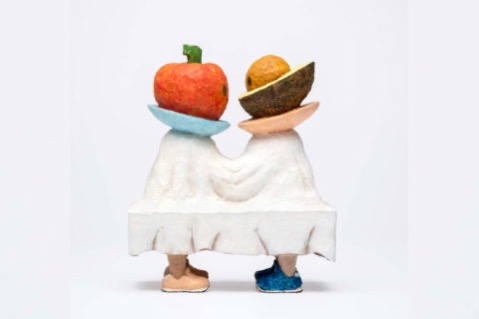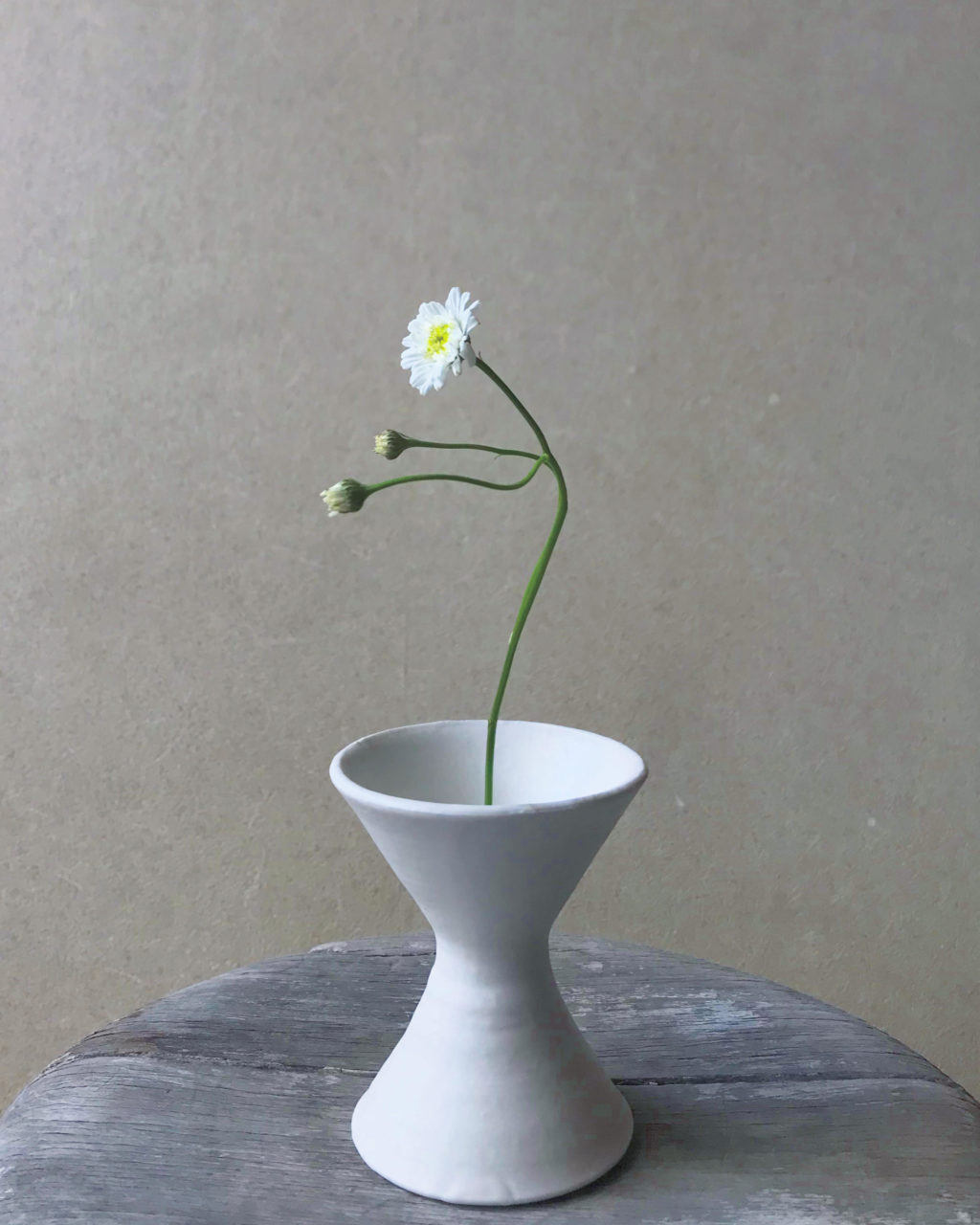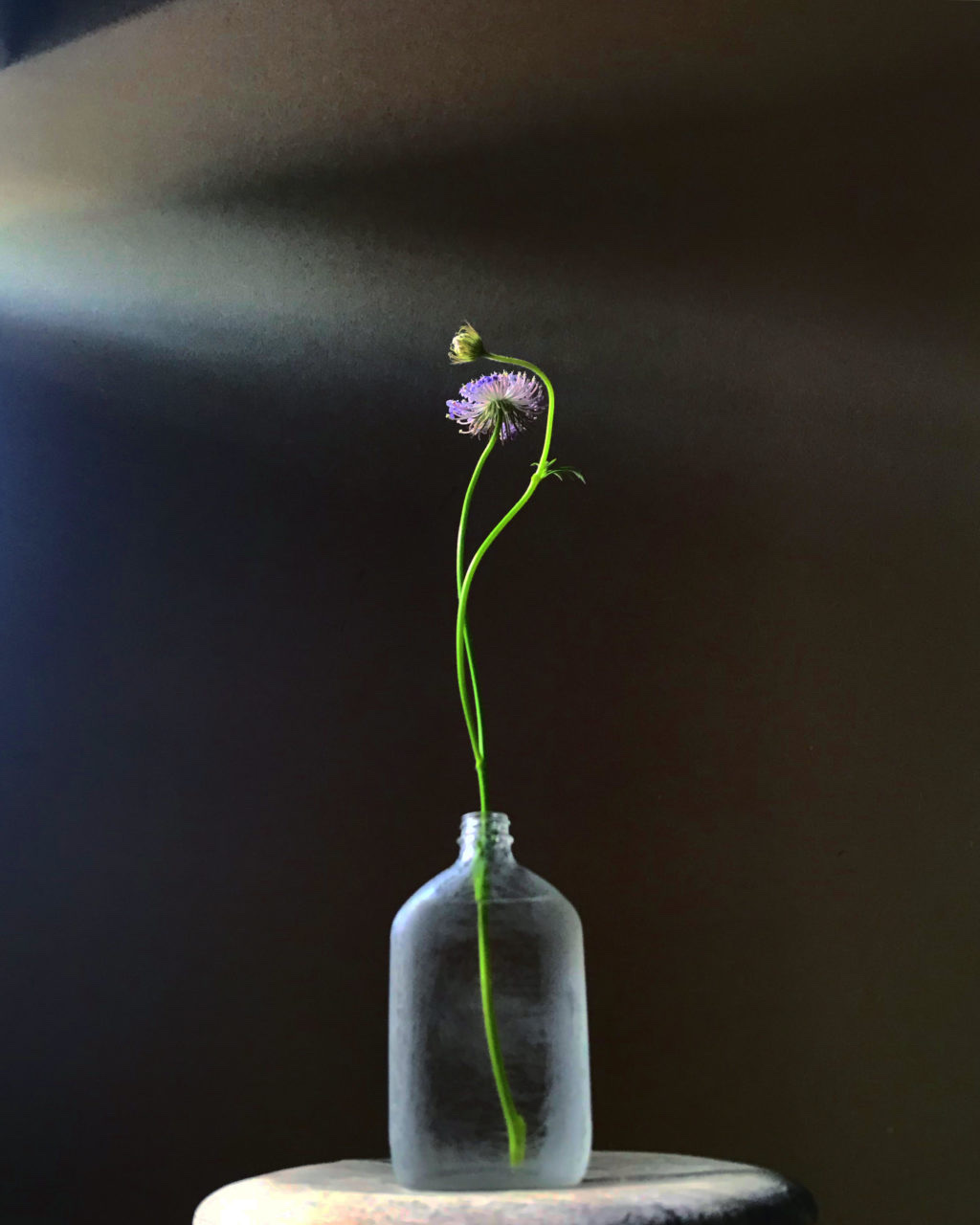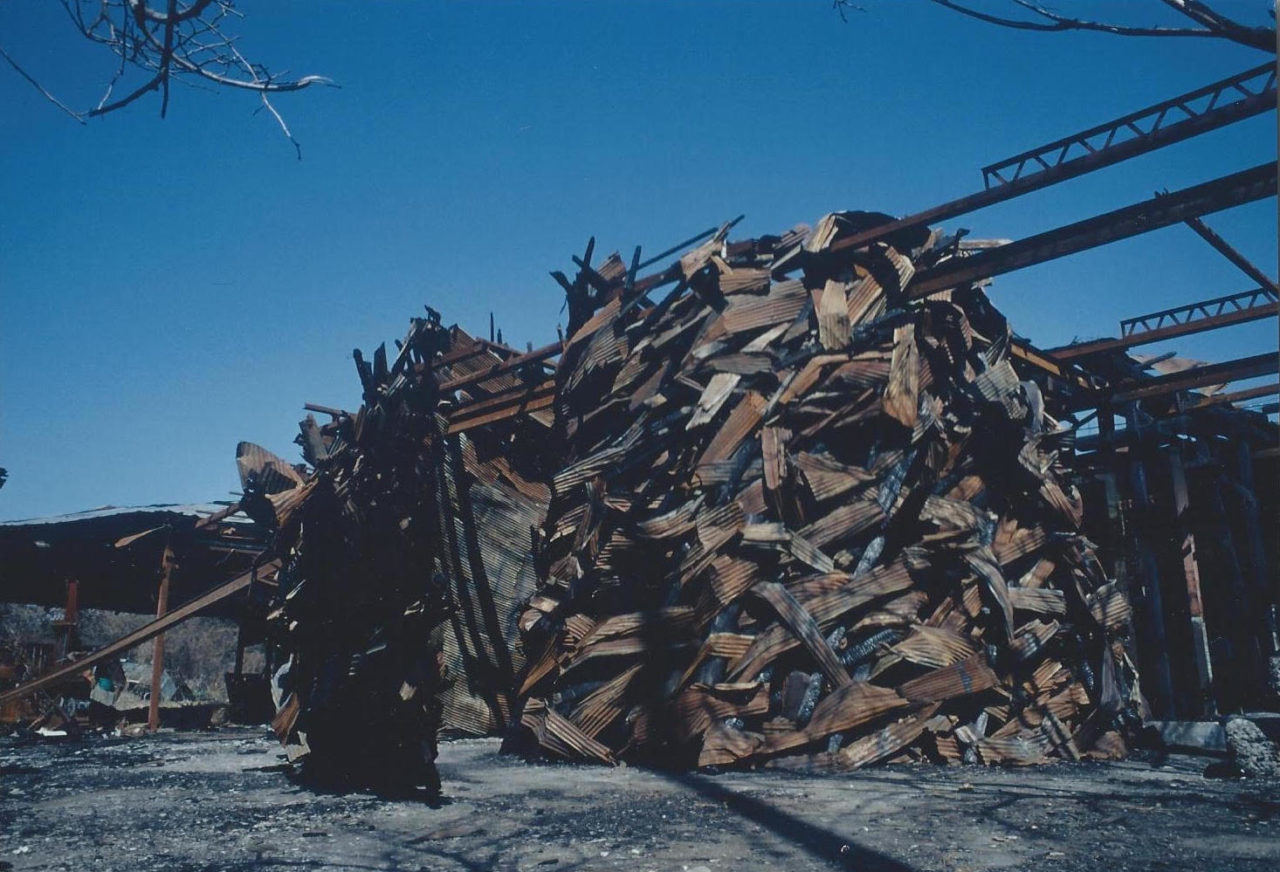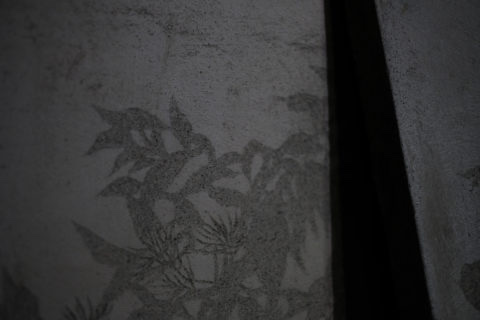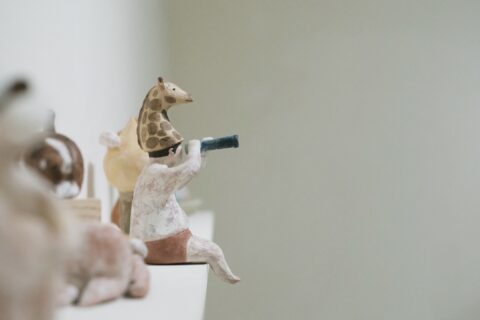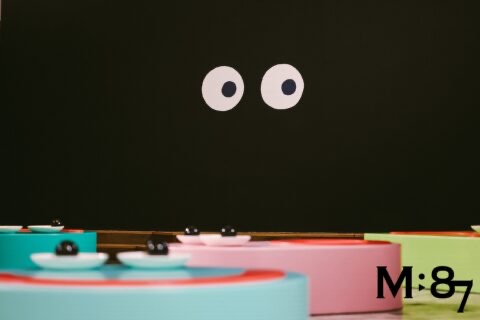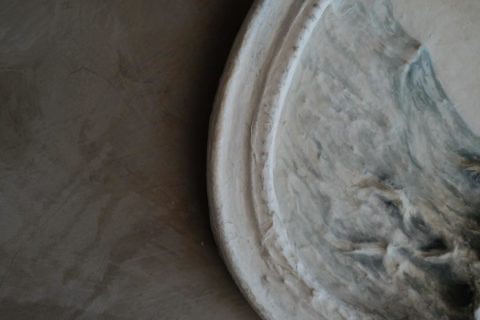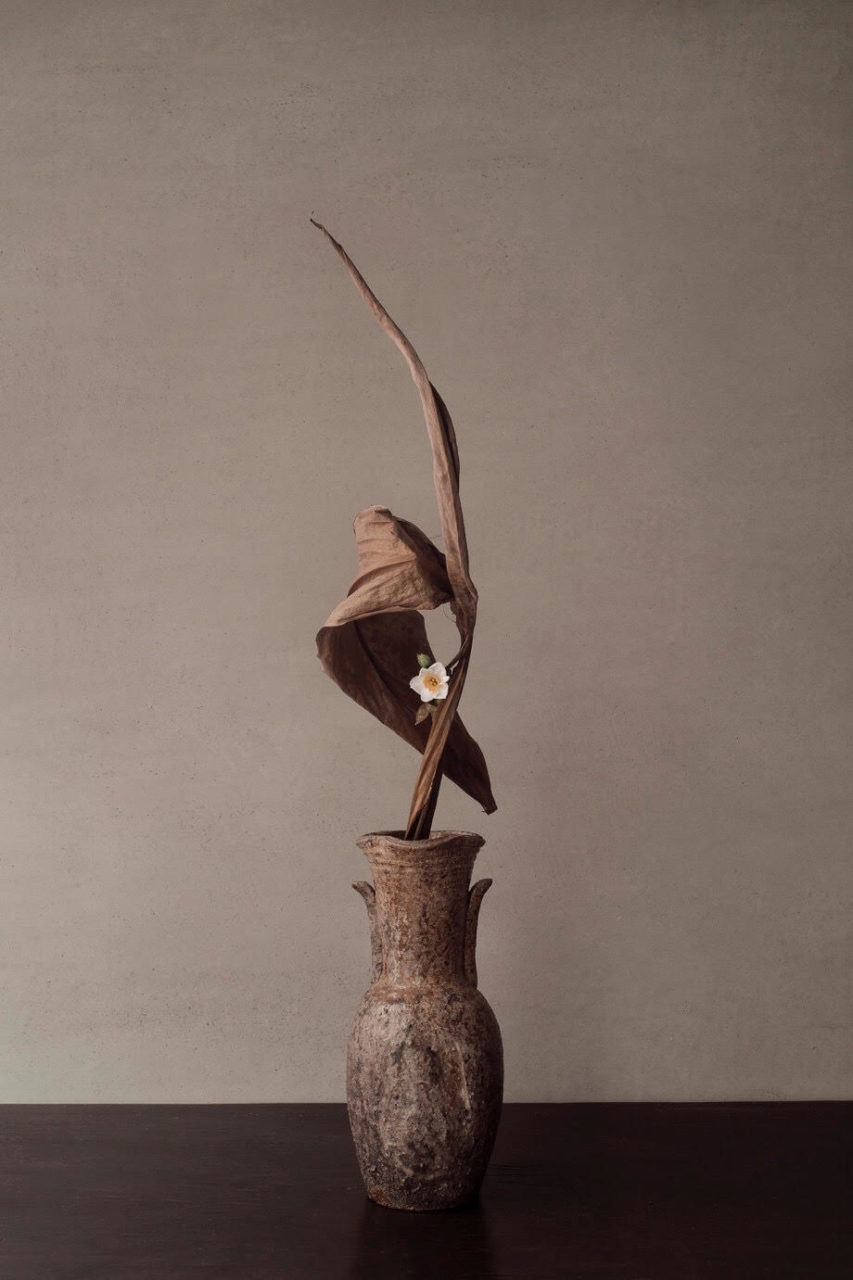
「因為新冠病毒大流行的關係,現在的我正在自我隔離中。自四月以來,我一直在家裡進行創作,並在社交媒體上發布。這段期間,我堅持使用幾乎在每一個家中都能找到的器皿來插花,如水杯、玻璃瓶和其他家裡的器皿。我也會挑選一些平價或是路上的野花作為材料。這系列以家的日常為主題,名為『謙卑中的喜悅』。」日本花道家上野雄次說。在十九歲的春天,他偶爾看到了花道家勅使河原宏的個展,被深深地感動,也打破了他對花道的想像。花道不一定是在榻榻米上正襟危坐、溫柔地弄著花枝;更可以是有力量和感染力的藝術。即使是最平凡的家,也能找到讓人心動的地方。
自此之後,上野雄次由一個不愛學習,終日流連電影院和美術館的青年,變成一個投入花道三十多年的藝術家。由傳統的插花教室開始學習花道,上野經歷過迷失、失去研習花道的動力。上野曾說他無法透過那些細緻纖柔的花來表達自已,相反地,從路邊細小而生命力強大的野花中,他得到了共鳴,於是他的創作不只限於鮮花,還有各種個性鮮明的樹幹、枯枝來創作,呈現大自然的真實面貌。
「無論如何,我認為花道最重要的是不被任何概念所束縛。」上野雄次說他四十歲才開始學懂插花,終於做出「能看」的作品。他的花道不只限於植物、器皿,還可以結合音樂、舞蹈和影像,以現場表演的方式讓觀眾感受花的生命,他使用繩索捆綁、激烈地擊打和殘忍地摧毀鮮花,在花瓣掉下、鮮花死去的一剎,誕生了「生」的欲望。一如上野雄次所說,把花放在一旁,它不會感到幸福的。只有把它與時間、空間和人相遇,才能成為一種抵抗的力量,帶來更震撼人心的效果。在這段自我隔離的日子裡,人人都在抵抗不被病毒感染,在抵抗與順應自然之間,花道使人懂得謙卑地對待大自然,身處危難中也能得到喜悅自在。
“Due to the coronavirus pandemic, I am now in quarantine. Since the first half of April, I have continued to work on ikebana at home and to post on social media. What I insist on with respect to my flower arrangement during this period is the use of containers which can be found practically in every household, such as empty bottles, glasses as well as other household objects. Similarly, regarding the flowers, I have taken to using those which can be bought at florists at a low price or wildflowers springing up by the roadside. My theme is the humble joy brought into being within an ordinary family environment,” said Yuji Ueno, a Japanese ikebana artist. Ueno’s interest in ikebana, the Japanese art of flower arrangement, started when he randomly came across an exhibition by the celebrated ikebana artist Hiroshi Teshigahara at the age of 19. Teshigahara’s work shocked Ueno; they moved him deeply, and at the same time completely changed his long-standing imagination and understanding of ikebana. To Ueno, ikebana was no longer a solemn practice of floral arrangement, but a powerful and inspirational art form that can bring wonder and magic even to the most ordinary households.
Ever since then, Ueno has completely devoted himself to the practice of ikebana. He was no longer the young boy that hated school and wandered days and nights at the cinemas and art museums. He started going to traditional flower arrangement classes and experienced all of the ups and downs that come with learning. It has been over thirty years now since this all began. Ueno once said that he could not express himself through soft and delicate flowers. On the contrary, he resonates most with the small, yet energetic wildflowers that grow on the side of the road. For that, his work does not only include flowers, but also various tree trunks and branches with distinctive characteristics that can reveal the most honest and genuine side of nature.
“In any case, I think it is important not to be bound by any fixed concepts.” Ueno said that he only started to really understand flower arrangement, and was finally able to create something “presentable,” at the age of 40. His artwork does not only include plants and vessels. He also incorporates music, dance, and images to enhance live performances that allow audiences to witness the life and death of flowers. He would tie the flowers with ropes, beat them fiercely, and brutally destroy them. When the last petal falls and the flower dies, the desire to “live” was born. As Ueno once said, if you put the flowers aside, they won’t be happy. Only if they encounter time, space and other people, can they become a force of resistance that can move people’s hearts. In the time of pandemic when everyone is fighting hard against the virus, ikebana shows us the most humble way to deal with nature, and that we can find joy even in crisis.
O: Obscura
U: Ueno Yuji
O:你在這三十多年來一直研習花道,過程中經歷甚麼轉變嗎?
U:在開始的十年,我把大部分的精力投入在透過植物來表現物體的形態,以及創作裝置藝術,當中依據花道的基礎概念來創作,並沒有加入自己的情感表達。當然,這是插花練習的一部分,過程中看到的影像和認識到的哲學理論,形成了我日後想要表達的核心概念。
到了三十歲左右,我開始得到了把作品公開的機會,可是,我卻在那段時間裡失去了研習花道的動力。於是,我又回到原點尋找對花道的熱誠。自此開始,即使是簡單的插花動作,我也會以認真的態度去看待。我在三十五歲時離開了學校,並獨立起來,幾年後便成為了導師。
O:你把傳統的花道融合了音樂和表演藝術,為甚麼你會有這樣的想法?
U:大約十八年前,一位畫廊的老闆看到我的藝術裝置後,提議我做現場表演,感謝他的鼓勵,讓我下決心嘗試作表演。這使我有機會接觸與當代舞蹈結合的藝術性表演,然後我漸漸對這種表現方式產生濃厚的興趣。關於花道的表現,時間的流逝是不可或缺的因素,這是因為花朵是鮮豔而生動的。加上,觀眾能夠親眼看到創作的過程,同時見證了鮮花在時間流逝下的形態。這種同步的覺察,表達了花道的概念和哲學,也成為了我表演的重要動力。
O:可以分享你對花道的想法嗎?
U:花道是一種文化的形式,也是一種娛樂。我們能透過插花來滋養心靈,這相等於畫畫和唱歌帶來的經驗。花道是一種源自日本的花卉設計,它的起源可追溯至大約六百年前。在悠長的歷史裡,不同時期出現了各種流行的風格,當中有不少以視覺效果作為主導的創作,都是呼應著過去一些經典的風格。我認為若要了解現今世界的花道,必需是基於對過去的了解、尊重和接受過去的事情,還有感悟力,以及持續地了解現在需要完成的是甚麼。因此,我現在做的花藝與過去有不同之處是很自然的事情。
O:你是如何看待人類與自然的關係?
U:首先,我要說人類是自然的一部分。一般來說,自然是一種人類無法控制的存在,在自然裡,與人類最相似的存在就是植物。植物如人類一樣,都是有生命的物體。蔬菜等植物可以作為食物,也提供著氧氣和成為地球裡儲存水分的系統,以維持地球穩定的溫度。植物使人類得以生存,我很感恩。此外,我們必須接受和面對人類無法控制、不可逆轉的事情,包括流行病、地震和糧食,我們需要學會與恐懼共存。
O: You have been doing ikebana for more than 30 years, what changes have you made in these years?
U: Within the first ten years or so since I began to learn ikebana, I mainly focused on the creation and expression performance of objects and installations based on the concept of ikebana using plants, without ever presenting ikebana works as my own expressions. Certainly, I have done flower arrangement as part of my training, and the images and philosophy that I have gained during the process have formed the core of my expressions.
Around the age of 30, I began to get the opportunity to gradually make public my ikebana creations. Around that time, I lost the motivation to continue working on ikebana. In the sense of confronting my starting point, I took on flower arrangement while beginning to regain my motivation. I have become used to approaching the uncomplicated act of flower arrangement in a serious manner. At 35, I quit the school I belonged to and became independent. A few years later, I became an instructor.
O:You have interated ikebana into music and performing arts, why do you have such an idea?
U: It was around 18 years ago, a gallery owner, who saw me working on an installation, recommended that I should do performances. Thanks to this encouragement, I made a resolve to start doing performances. When I began live performances, I had the chance to come in touch with performances as a form of artistic expressions and contemporary dance. Then I began to take an interest also in live performances as a form of expression. Concerning the expression of Ikebana, the passage of time is an essential element. It is because flowers are vivid. In addition, spectators are face-to-face with the creations right before their eyes. And this element applies to live performances in the exact same way. This awareness corresponds to an essential motivation of my beginning to pass on the concepts and philosophy of ikebana through performances.
O:Can you share your views on ikebana?
U: Ikebana is a form of culture. It is a form of entertainment allowing us to nourish our mind through arranging flowers. It is equivalent to the experience gained from drawing and singing. Ikebana is a style of flower design originally from Japan. Its origin can be traced back to around 600 years ago. Given its long history, each period has given birth to a popular style. The many creations which have dominated the visual images of ikebana correspond to a classical style from the past. In my view, the process of realizing ikebana in the modern world is based on a profound understanding, respect and acceptance of past events, and a perception and continuing realization of what should be done at present. In this sense, it is natural that my current ikebana creations are different from those in the past.
O:What do you think about the relationship between human beings and nature?
U:First of all, I would state that human beings are a part of nature. Generally speaking, I think nature refers to the existence which is beyond the control of human forces, and in nature, the most symbolic existence for human beings is plants. Like us human beings, plants are living things. Plants such as vegetables can serve as food and they also serve as a source of oxygen, and as a system for storing a suitable amount of water on the Earth’s surface, make it possible to maintain a stable temperature. We can consider that plants contribute to the survival of human beings. I am grateful for that. In addition, while accepting and confronting the inevitable existence of things beyond our control, including epidemics, earthquakes and foods, we need to learn to coexist with fear.
O:你曾與酒店、音樂人和工匠等不同的單位合作,當中有沒有難忘的經驗?
U:即興的現場表演尤其令人興奮和激動人心。沒有任何預先的準備和決定下一步如何去做是一件非常有趣的事情。音樂家是很適合這種即興的現場表演,因為他們需要一個方式去伸延和轉變聲音。在現場表演的裝置裡擁有一份真誠,花道對其他人來說,遠遠不能代替音樂的表達形式。而我能夠置身於這份真誠的感受之中,實在太奇妙了。
O:當你在森林或是大自然裡尋找創作的原料時,有沒有一些標準?
U:當我要去創作時,我會走進自然裡,並帶著收集個性鮮明的材料為目的。你可以把這過程看成是為一齣電影或舞台劇的角色面試。我只是簡單地依靠人類的感覺去挑選,這是來自人類對自然創造的欣賞,與植物或生物學無關。最重要是你對它能否產生情感。
O:你怎樣看「一花一世界」這句說話?
U:花道創作包含著各種訊息,可以是代表事物的本質、社會的狀況和個人的情感。花道是人類創造的一種活動,與電影、戲劇等文化活動是一樣的。花道也與音樂和舞蹈一樣,可以感染其他人。
O:對於將來,你有甚麼計劃或想做的事情?
U:我想繼續做我的花道創作,同時透過花道來為世界和平出一分力。現時沒有新的計劃,但我經常都渴望有新的挑戰呢。
O:Since you have worked with different units such as hotels, musicians, and craftsmen in the past, do you have any unforgettable experience?
U:Improvised live performances are particularly exciting and stimulating. It is interesting to start without any prior decision, and to decide on what to do next on the spot. Musicians are very much suited to such improvised performances as all they need to proceed and to transform is to ensure a way to produce sound. Within the setting of live performances, there is also a kind of honesty in the fact that ikebana, among others, is far from being able to overtake musical expressions. Since I am able to come in touch with this genuine feeling, it is simply fantastic.
O:Are there any criteria to select materials for ikebana when you are in the forest or nature?
U:If I need to work on ikebana, I step into nature with the purpose of collecting materials which have vibrant personalities. You may consider it as a process equivalent to an audition for film or theater roles. I choose simply based on the sensitivity of a human being because they are creations resulting from human activities for human beings’ appreciation. It does not concern the point of view of botany or biology. What is important is whether one can have an emotional involvement.
O:What do you think about the quote “One Flower One World”, we can see and realize the world through a flower?
U:An ikebana creation is packed with various kinds of information. In this sense, it is possible to represent the nature of things, social situations and personal emotions. Ikebana is an action performed by human beings, and the same goes for other cultures such as films and theatre. Given music and dance, among others, can achieve such representations, it is just obvious that ikebana can do the same.
O: Is there anything you want to do or plan in the future?
U: I would like to continue to work on ikebana and contribute to world peace through ikebana. As for plans, at this stage, I do not have any new experience in sight. I always want to have new challenges.

